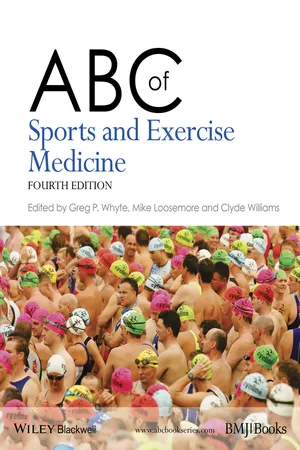
ABC of Sports and Exercise Medicine
- English
- ePUB (mobile friendly)
- Available on iOS & Android
ABC of Sports and Exercise Medicine
About This Book
The ABC of Sports and Exercise Medicine provides general practitioners with a comprehensive overview of the field of sports medicine. This highly illustrated and thoroughly revised and updated new edition: •Reflects new developments and current practice
•Includes new chapters on medical care at sporting events, environmental factors of sports and exercise, benefits of exercise in health and disease, nutrition and ergogenic supplements, and the use of drugs in sport
•Covers the benefits of exercise among special populations such as the disabled, obese, pregnant, children and the elderly Covering the latest topics and including case studies of common sports and exercise medicine conditions, the ABC of Sports and Exercise Medicine is an essential practical guide for general practitioners, family physicians, junior doctors, medical students, physiotherapists, and all health professionals dealing with the treatment and prevention of sports-related injuries.
Frequently asked questions
Information
Chapter 1
Epidemiology of Sports Injuries and Illnesses
OVERVIEW
- Sports injury and illness epidemiology research is continuing to grow
- Study design and methods can influence the conclusions made
- The definition of injury/illness, and rate and severity indices should be appropriate to the cohort of interest
- Identifying injury and illness causes will help to provide additional risk information
- Prevention initiatives should target the injury/illness issues posing the greatest risk
Introduction
| Sport | No. of athletes | No. of injuries (%) | No. of illnesses (%) |
| Archery | 128 | 2 (1.6) | 10 (7.8) |
| Athletics | 2079 | 368 (17.7) | 219 (10.5) |
| Diving | 136 | 11 (8.1) | 7 (5.1) |
| Swimming | 931 | 50 (5.4) | 68 (7.3) |
| Synchronised swimming | 104 | 14 (13.5) | 13 (12.5) |
| Water polo | 260 | 34 (13.1) | 21 (8.1) |
| Badminton | 164 | 26 (15.9) | 5 (3.0) |
| Basketball | 287 | 32 (11.1) | 9 (3.1) |
| Beach volleyball | 96 | 12 (12.5) | 18 (18.8) |
| Boxing | 283 | 26 (9.2) | 18 (6.4) |
| Canoe slalom | 83 | 2 (2.4) | 4 (4.8) |
| Canoe sprint | 249 | 7 (2.8) | 14 (5.6) |
| BMX | 48 | 15 (31.3) | 2 (4.2) |
| MTB | 76 | 16 (21.1) | 5 (6.6) |
| Road cycling | 210 | 19 (9.0) | 7 (3.3) |
| Track cycling | 167 | 5 (3.0) | 16 (9.6) |
| Equestrian | 199 | 9 (4.5) | 11 (5.5) |
| Fencing | 246 | 23 (9.3) | 13 (5.3) |
| Football | 509 | 179 (35.2) | 62 (12.2) |
| Artistic gymnastics | 195 | 15 (7.7) | 5 (2.6) |
| Rhythmic gymnastics | 96 | 7 (7.3) | 1 (1.0) |
| Trampoline | 32 | 2 (6.3) | 1 (3.1) |
| Handball | 349 | 76 (21.8) | 17 (4.9) |
| Hockey | 388 | 66 (17.0) | 29 (7.5) |
| Judo | 383 | 47 (12.3) | 16 (4.2) |
| Modern pentathlon | 72 | 6 (8.3) | 1 (1.4) |
| Rowing | 549 | 18 (3.3) | 40 (7.3) |
| Sailing | 380 | 56 (14.7) | 38 (10.0) |
| Shooting | 390 | 15 (3.8) | 17 (4.4) |
| Table tennis | 174 | 11 (6.3) | 12 (6.9) |
| Taekwondo | 128 | 50 (39.1) | 14 (10.9) |
| Tennis | 184 | 21 (11.4) | 4 (2.2) |
| Triathlon | 110 | 16 (14.5) | 7 (6.4) |
| Volleyball | 288 | 20 (6.9) | 8 (2.8) |
| Weightlifting | 252 | 44 (17.5) | 10 (4.0) |
| Wrestling | 343 | 41 (12.0) | 16 (4.7) |
Study design and population
Injury/illness definition
Table of contents
- Cover
- ABS Series
- Title Page
- Copyright
- Table of Contents
- List of Contributors
- PART I: INJURY
- PART II: SYSTEM SPORT AND EXERCISE MEDICINE
- PART III: ENVIRONMENTAL SPORT AND EXERCISE MEDICINE
- PART IV: SPECIAL POPULATIONS
- PART V: NUTRITION AND DOPING
- Index
- End User License Agreement